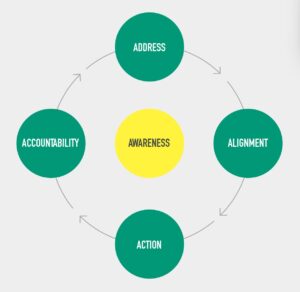Although Team Coaching is one of the fastest-growing disciplines of coaching according to the (ICF – International Coach Federation). it is still little understood. When I tell people that I am a team coach, one of the most common responses I get is, ‘oh really? Which sport?’
Given this understandable lack of knowledge about team coaching, I decided to explain what happens in the team coaching process by using what I call my ‘5A’ model of team coaching. So here goes…!

AWARENESS
Awareness is the greatest agent for change. Often teams have a level of awareness around their issues already but aren’t talking about the elephant in the room. They also sometimes can’t see what they need to, so the first stage is to make the team fully conscious and aware of all the challenges and concerns to be addressed during the coaching.
We do this to begin with during the pre-coaching assessment phase – stakeholder and team meetings, surveys – and continues in the team coaching room itself. We use structured team coaching exercises and tools to reveal what is going on within the team, encouraging open discussion, listening and an attitude of curiosity about what is unfolding as the conversation goes on.
ADDRESS
Once the team is aware of what’s happening, then the team coach can manage a process that guides the team through addressing it. This means getting things out in the open, having conversations and exploring the problem. This can be a bit daunting, but the team coach is there to facilitate honest, respectful and productive dialogue without letting it be a negative or pointless exercise. It’s important that the team allows all the voices to be expressed, listens attentively and doesn’t judge anything that is being expressed.
The team coach’s job is to notice everything, and hold a space for meaningful discussion. Sometimes we draw attention to things that are being expressed, stepping in to guide the conversation – but also knowing when to fade out and let the conversation flow, if it is productive and positive.
ALIGNMENT
Once the team has consciously and intentionally worked through the issues at hand, then the coach works to help bring the team together as an aligned unit. This is especially powerful when there are silos and divisions within a team. An aligned team can be unified behind a common desire to move forward.
Teams will probably not always agree on everything – hence using the word ‘alignment’ instead of ‘agreement’ for the fourth step. People can hold opposing viewpoints and disagree with the course of action chosen, but they can still commit even if it’s not how they would do it. But the important point is that they have been given every opportunity to share their opinion, listen to others, and understand that the team’s direction is where the team needs to go. This increases the sense of alignment behind these decisions and therefore much higher levels of engagement and commitment.
ACTION
Once alignment is reached, the team co-creates a meaningful, concrete action plan. The fact that they come up with this themselves rather than being told what to do is tremendously powerful. The actions are relevant, concrete behavioural practices that the team identify as essential to the change that they desire.
Having these clear guidelines creates greater awareness and commitment from the members of the team on how to behave, communicate, interact and have healthy conflict on the team.
ACCOUNTABILITY
Because the team have worked through the previous steps, they have a plan that they have created themselves. The coach cements this plan within the team so that every member is committed and clear on what they and everyone else needs to do. The true power of going through the coaching experience is for the team to hold each other highly accountable to the plan because they have created it, and because commitment has been proactively secured during the coaching.
Giving everyone the chance to contribute towards their intentions around right (and wrong) behaviour means that commitment and accountability are much higher than if terms are dictated to the team members. Team coaching gives the opportunity to the team to be masters of their own destiny.
Trying to tell people how to do things has limited effect. People might even nod and say they will do things, but inside, they are silently saying no. Then they disengage and go back to doing things the old way. Team coaching is about forward looking action and change – changes to behaviour and how we do things. The 5A model helps teams to build a conscious, clear and forward looking ethos and culture, so that they can achieve the results they set out to go for in the first place.
You can also watch my 5A Coaching Model explanation video on Youtube – Click here to watch.
HOW TO GET IN TOUCH
Call me on +971 (0)50 559 5711 or send me a message